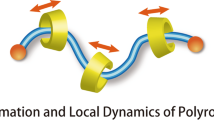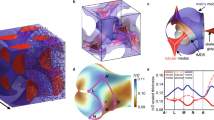Abstract
Block-copolymer amphiphiles have been observed to assemble into vesicles and other morphologies long known for lipids but with remarkably different properties. Coarse-grain molecular dynamics (CG-MD) is used herein to elaborate the structures and properties of diblock copolymer assemblies in water. By varying the hydrophilic/hydrophobic ratio of the copolymer in line with experiment, bilayer, cylindrical and spherical micelle morphologies spontaneously assemble. Varying the molecular weight (MW) with hydrophilic/hydrophobic ratio appropriate to a bilayer yields a hydrophobic core thickness that scales for large MW as a random coil polymer, in agreement with experiment. The extent of hydrophobic-segment overlap in the core increases nonlinearly with MW, indicative of chain entanglements and consistent with the dramatic decrease reported for lateral mobility in polymer vesicles. Calculated trends with MW as well as hydrophilic/hydrophobic ratio thus agree with experiment, demonstrating that CG-MD simulations provide a rational design tool for diblock copolymer assemblies.
This is a preview of subscription content, access via your institution
Access options
Subscribe to this journal
Receive 12 print issues and online access
$259.00 per year
only $21.58 per issue
Buy this article
- Purchase on Springer Link
- Instant access to full article PDF
Prices may be subject to local taxes which are calculated during checkout






Similar content being viewed by others
References
Discher, B.M. et al. Polymersomes: Tough vesicles made from diblock copolymers. Science 284, 1143–1146 (1999).
Cornelissen, J.L.M., Fisher, M., Sommerdijk, N.A.J.M. & Nolte R.J.M. Helical superstructures from charged poly(styrene)-poly(isocyanodipeptide) block copolymers. Science 280, 1427–1430 (1998).
Meier, W., Nardin, C. & Winterhalter, M. Reconstitution of channel proteins in (polymerized) ABA triblock copolymer membranes. Angew. Chem. Int. Edn 39, 4599–4602 (2000).
Nardin, C., Widmer, J., Winterhalter, M. & Meier, W. Amphiphilic block copolymer nanocontainers as bioreactors. Eur. Phys. J. E 4, 403–410 (2001).
Okada, J., Cohen, S. & Langer, R. In-vitro evaluation of polymerized liposomesas an oral-drug delivery system. Pharmaceut. Res. 12, 576–582 (1995).
Discher, D.E. & Eisenberg, A. Polymer vesicles. Science 297, 967–973 (2002).
Hamley, I.W. Nanostructure fabrication using block copolymers. Nanotechnology 14, R39–R54 (2003).
Napoli, A.V., Valentini, M., Tirelli, N., Müller, M. & Hubbell, J.A. Oxidation-responsive polymeric vesicles. Nature Mater. 3, 183–189 (2004).
Zhang, L.F. & Eisenberg, A. Multiple morphologies of crew-cut aggregates of polystyrene-B-poly(acrylic acid) block-copolymers. Science 268, 1728–1731 (1995).
Jain, S. & Bates, F.S. On the origins of morphological complexity in block copolymer surfactants. Science 300, 460–464 (2003).
Tew, G.N. et al. De novo design of biomimetic antimicrobial polymers. Proc. Natl Acad. Sci. USA 99, 5110–5114 (2002).
Lipowsky, R, & Sackman, E. (eds) Structure and Dynamics of Membranes (Elsevier, Amsterdem, 1995).
Cevc, G. Phospholipids Handbook (Marcel Decker, New York, 1993).
Chakraborty, A.K. & Golumbfskie, A.J. Polymer adsorption driven self-assembly of nanostructures. Ann. Rev. Phys. Chem. 52, 537–573 (2001).
Balsara, N.P., Garetz, B.A., Newstein, M.C., Bauer, B.J. & Prosa, T.J. Evolution of microstructure in the liquid and crystal directions in a quenched block copolymer melt. Macromolecules 31, 7668–7675 (1998).
Forster, S., Zisenis, M., Wenz, E. & Antonietti, M. Micellization of strongly segregated block copolymers. J. Chem. Phys. 104, 9956–9970 (1996).
Needham, D. & Zhelev, D.V. The Mechanochemistry of Lipid Vesicles Examined by Micropipette Manipulation Techniques in Vesicles (ed. Rosoff, M.) Ch. 9 (Marcel Dekker, New York, 2000).
Bermudez, H., Brannan, A.K., Hammer, D.A., Bates, F.S. & Discher, D.E. Molecular weight dependence of polymersome membrane structure, elasticity, and stability. Macromolecules 35, 8203–8208 (2002).
Hillmyer, M.A. & Bates, F.S. Synthesis and characterization of model polyalkane-poly(ethylene oxide) block copolymers. Macromolecules 29, 6994–7002 (1996).
Pakula, T., Karatasos, K., Anastasiadis, S.H. & Fytas, G. Computer simulation of static and dynamic behavior of diblock copolymer melts. Macromolecules 30, 8463–8472 (1997).
Schultz, A.J., Hall, C.K. & Genzer, J. Computer simulation of copolymer phase behavior. J. Chem. Phys. 117, 10329–10338 (2002).
Pastor, R.W., Venable, R.M., Karplus, M. & Szabo, A. A simulation based model of nmr T1 relaxation in lipid bilayer vesicles. J. Chem. Phys. 89, 1128–1140 (1988).
Noguchi, H. & Takasu, M. Fusion pathways of vesicles: A Brownian dynamics simulation. J. Chem. Phys. 115, 9547–9551 (2001).
Noguchi, H. Fusion and toroidal formation of vesicles by mechanical forces: A Brownian dynamics simulation. J. Chem. Phys. 117, 8130–8137 (2002).
Srinivas, G. & Bagchi, B. Detection of collapsed and ordered polymer structures by fluorescence resonance energy transfer in stiff homopolymers: Bimodality in the reaction efficiency distribution. J. Chem. Phys. 116, 837–844 (2002).
Smit, B. et al. Structure of a water/oil interface in the presence of micelles: a computer simulation study. J. Phys. Chem. 95, 6361–6368 (1991).
Goetz, R., Gompper, G. & Lipowsky, R. Mobility and elasticity of self-assembled membranes. Phys. Rev. Lett. 82, 221–224 (1999).
Shelley, J.C., Shelley, M.Y., Reeder, R.C., Bandyopadhyay, S. & Klein, M.L. A coarse grain model for phospholipid simulations. J. Phys. Chem. B 105, 4464–4470 (2001).
Tieleman, D.P. & Marrink, S.J. Potential of mean force of a lipid in a lipid bilayer. Biophys. J. 84, 368–369 (2003).
Tieleman, D.P., Leontiadou, H., Mark, A.E. & Marrink, S.J. Simulation of pore formation in lipid bilayers by mechanical stress and electric fields. J. Am. Chem. Soc. 125, 6382–6383 (2003).
Marrink, S.J. & Tieleman, D.P. Molecular dynamics simulation of a lipid diamond cubic phase. J. Am. Chem. Soc. 123, 12383–12391 (2001).
Marrink, S.J., Lindahl, E., Edholm, O. & Mark, A.E. Simulation of the spontaneous aggregation of phospholipids into bilayers. J. Am. Chem. Soc. 123, 8638–8639 (2001).
Marrink, S.J. & Mark, A.E. Effect of undulations on surface tension in simulated bilayers. J. Phys. Chem. B 105, 6122–6127 (2001).
Marrink, S.J. & Mark, A.E. Molecular dynamics simulation of the formation, structure, and dynamics of small phospholipid vesicles. J. Am. Chem. Soc. 125, 15233–15242 (2003).
Nielsen, S.O. & Klein, M.L. Bridging Time Scales: Molecular Simulations for the Next Decade (eds Nielaba, P., Mareschali, M. and Ciccotti, G.) 27–63 (Elsevier Science, Amsterdam, 2003).
Shelley, J.C. et al. Simulations of phospholipids using a coarse grain model. J. Phys. Chem. B 105, 9785–9792 (2001).
Nielsen, S.O., Lopez, C.F., Moore, P.B., Shelley, J.C. & Klein, M.L. Molecular dynamics investigations of lipid langmuir monolayers using a coarse-grain model. J. Phys. Chem. B 107, 13911–13917 (2003).
Srinivas, G., Shelley, J.C., Nielsen, S.O., Discher, D.E. & Klein, M.L. Simulation of diblock copolymer self-assembly using a coarse-grain model. J. Phys. Chem. B 108, 8153–8160 (2004).
Lindahl, E. & Edholm, O. Spatial and energetic-entropic decomposition of surface tension in lipid bilayers from molecular dynamics simulations. J. Chem. Phys. 113, 3882–3893 (2000).
Feller, S.E., Zhang, Y.H. & Pastor, R.W. Computer-simulation of liquid/liquid interfaces. 2. Surface-tension area dependence of a bilayer and monolayer. J. Chem. Phys. 103, 10267–10276 (1995).
Feller, S.E. & Pastor, R.W. Constant surface tension simulations of lipid bilayers: The sensitivity of surface areas and compressibilities. J. Chem. Phys. 111, 1281–1287 (1999).
Goetz, R. & Lipowsky, R. Computer simulations of bilayer membranes: self-assembly and interfacial tension. J. Chem. Phys. 108, 7397–7409 (1998).
Rao, M. & Levesque, D. Surface structure of a liquid film. J. Chem. Phys. 65, 3233–3236 (1976).
Bermudez, H., Hammer, D.A. & Discher, D.E. Effect of bilayer thickness on membrane bending rigidity. Langmuir 20, 540–543 (2004).
Israelachvili, J.N. Intermolecular and Surface Forces (Academic, San Diego, California, 1998).
Mark, J.E. Physical Properties of Polymers Handbook (AIP Series in Polymers and Complex Materials, AIP, New York, 1996).
Lee, J.C.M., Law, R.J. & Discher, D.E. Bending contributions hydration of phospholipid and block copolymer membranes: Unifying correlations between probe fluorescence and vesicle thermoelasticity. Langmuir 17, 3592–3597 (2001).
Lee, J.C.M., Santore, M., Bates, F.S. & Discher, D.E. From membranes to melts, rouse to reptation: Diffusion in polymersome versus lipid bilayers. Macromolecules 35, 323–326 (2002).
Acknowledgements
We would like to thank John C. Shelley, Carlos Lopez, Steve Nielsen, Ivaylo Ivanov and Preston B. Moore. This work has been supported by the National Science Foundation (Pennsylvania University's Materials Research Science and Engineering Centre) and the National Institutes of Health.
Author information
Authors and Affiliations
Corresponding author
Ethics declarations
Competing interests
The authors declare no competing financial interests.
Supplementary information
Rights and permissions
About this article
Cite this article
Srinivas, G., Discher, D. & Klein, M. Self-assembly and properties of diblock copolymers by coarse-grain molecular dynamics. Nature Mater 3, 638–644 (2004). https://doi.org/10.1038/nmat1185
Received:
Accepted:
Published:
Issue Date:
DOI: https://doi.org/10.1038/nmat1185
This article is cited by
-
Investigation of intrinsic characteristics of polymer blends via molecular simulation: a review
Korea-Australia Rheology Journal (2023)
-
Tunable and scalable fabrication of block copolymer-based 3D polymorphic artificial cell membrane array
Nature Communications (2022)
-
Effect of the Nanoparticle Functionalization on the Cavitation and Crazing Process in the Polymer Nanocomposites
Chinese Journal of Polymer Science (2021)
-
Tuning the Electrically Conductive Network of Grafted Nanoparticles in Polymer Nanocomposites by the Shear Field
Chinese Journal of Polymer Science (2020)
-
Molecular understanding of interactions, structure, and drug encapsulation efficiency of Pluronic micelles from dissipative particle dynamics simulations
Colloid and Polymer Science (2019)



